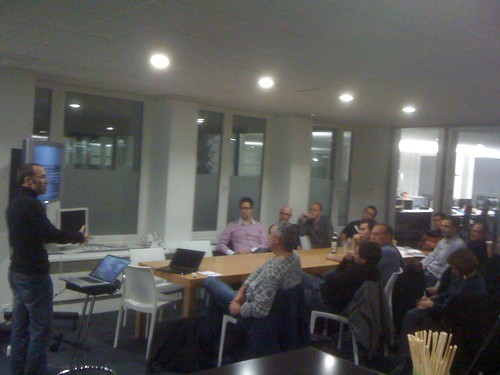Talk at Lift@Home in Geneva
Posted: November 10th, 2009 | No Comments »Yesterday, I delivered my last formal talk of the year at the Lift @ home session on “Urban informatics / Les nouveaux paysages numériques“, organized by Nicolas Nova in the Lift Conference premises in Geneva. This event was part of the urban informatics workshop series Nicolas and have been running. I played the role of the utilitarian to engage the audience on the potentials benefits of exploiting the logs of digital activities in our contemporary cities. My established spiel was enhanced with some insights from a recent study of crowd dynamics at the Puerta del Angel/Rambla area in Barcelona. As usual, the slides of “L’analyse urbaine à partir des activités numériques” are online for your downloading pleasure.
It was a pleasure to finally tag team with Boris Beaude from EPFL who brought his geographer’s reading of the notion of digital spaces and the maps they entail (read “Internet, un lieu du Monde” in the book L’invention du Monde, and see his courses at SciencePo Enjeux politiques de la géographie and Théorie de l’espace at EPFL). His insights help raise the kind of reflexive awareness need to reduce the effect of map designers’ personality/background on what is finally produced (see his recent paper Crime Mapping, ou le réductionnisme bien intentionné). He delivered a compelling argument on the reductionism of crime maps visualizations, highlighting the classic misleading error of calculating the density of a phenomena from the density of residents. Furthermore, these representation rely on citizen’s declarations, while it is well known that the most dangerous areas of a city are where there is a fear to report crimes. Among other issues, this calls the attention on the lack of critical thinking on “what does this information informs us on?” and who is responsible for the mishandling and misrepresentation of the data?

Boris Beaude at the improvised cabaret in the Lift Conference premises
The third speaker, Pascal Wattiaux discussed the role of technologies in the production of the olympic games. Each of the project run for at least 10 years, with each candidacy strongly embedded into the city planning, compressing 30 of development into roughly 7 years with no escape and a constant acceleration and organizational ramp-up (growing from 350 to 150.000 people in a few years). The games experience goes from the preparation of the games, through the production of the games, and the legacy of the games. It must be in sync with the expectation of the various stakeholders (public, athletes, workforce, sponsors, municipal, regional and state governments, etc).
In that unique context, technologies constantly offer opportunities in both revenue opportunities and cost savings. However, with the constant evolutions of technologies, it is hard to build “best practices”, therefore organizers report on “best experiences”.
Nowadays there are opportunities in the analysis of the spatial dynamics of the organization, could improve the spectators management (the stadium need to be full, it is a question of image), reduce the staff of volunteers, or organize the emergency operations with specific language competences.

